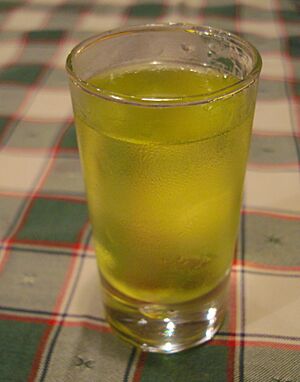Orujo facts for kids
Orujo is a strong, clear drink from northern Spain. It's a type of pomace brandy, which means it's made from the solid parts of grapes left over after they've been pressed to make wine. These leftovers include grape skins, seeds, and stalks. The name Orujo comes from the Spanish phrase "aguardiente de orujo", meaning "grape spirit."
This drink is very popular in northern Spain, especially in Galicia, but also in Asturias, Castile and León, and Cantabria (especially in the Liébana valley). People sometimes call it augardente or aguardiente (which means "firewater"), or caña. For some families, making Orujo is a special craft. After they make wine for themselves, they distill the grape leftovers in a small pot still. In recent years, many high-quality Orujo drinks have appeared from commercial producers. These are made from good grapes and follow strict rules, slowly replacing the traditional homemade versions.
Contents
How Orujo is Made
The main ingredient for Orujo is what's left after grapes are pressed for wine. These leftovers, called orujos, include the grape skins, seeds, and stalks. First, these parts are fermented in closed containers. Then, they are distilled.
The stills used for distilling are traditionally large copper kettles called alambiques, alquitaras, or potas. These kettles are heated over an open fire. The person making the Orujo, called a poteiro, carefully watches the process. The distilling can take six hours or even longer. The copper stills used by people in Galicia for centuries are believed to have been brought to Spain a long time ago.
The Orujo that comes out of the still is a clear, colorless liquid. However, there is also an "aged Orujo" called orujo envejecido, which has an amber color. This aged version is made the same way, but then it's put into oak barrels. It stays in these barrels for at least two years to get its special color and flavor.
History of Orujo
Orujo is made in both northern Portugal and northern Spain. In Spain, people in the monasteries of Liébana, Cantabria, have been distilling Orujo since the Middle Ages. Every November, the town of Potes celebrates the 'Fiesta del Orujo'. This festival includes tastings and a contest where people distill Orujo in public using their own stills. Judges then give a prize for the best-tasting batch.
Since the 1500s, families in Galicia have made Orujo on their farms. They are very proud of their drink, and each family often keeps their own secret recipe. Today, there are more than 20 companies that commercially produce Orujo under a special quality label called Denominación Específica Orujo de Galicia, which started in 1989.
Drinks Made with Orujo
People in Galicia traditionally use Orujo to make a drink called queimada, which means "burnt." To make it, bits of lemon peel, sugar, and ground coffee are put into a clay pot. Then, Orujo is poured over them. The pot is set on fire and allowed to burn until the flame turns blue.
In the mountain areas of Cantabria, León, and Asturias, there are a few main types of Orujo drinks. Besides the original clear Orujo, there is orujo de hierbas (Orujo with herbs), orujo de café (Orujo with coffee), and crema de orujo (Orujo cream).
Similar Drinks Around the World
Other countries also make drinks similar to Orujo, though they have different names and features. For example, France has marc, Italy has grappa, and Portugal has bagaceira. In Bulgaria, Serbia, and Greece, a similar drink is called rakia. In Spain, Orujo is also sometimes called augardente or aguardiente.
The word orujo can also mean the grape leftovers themselves, before they are distilled into the drink.
See also
 In Spanish: Orujo para niños
In Spanish: Orujo para niños



